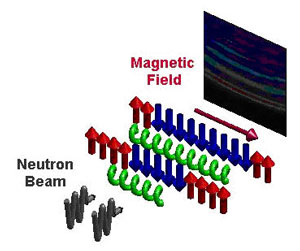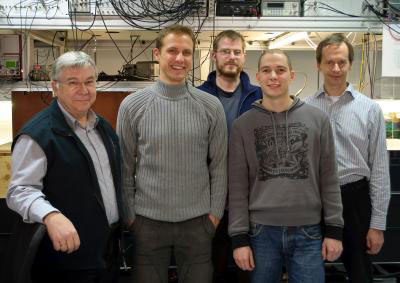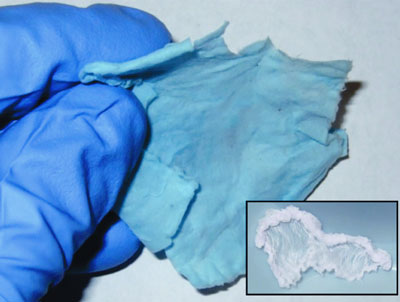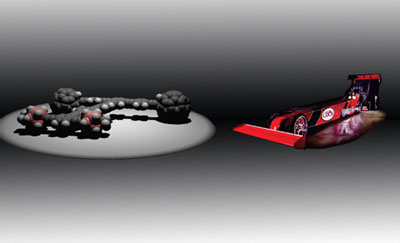University of Michigan researchers have discovered the rules that dictate the three-dimensional shapes of RNA molecules, rules that are based not on complex chemical interactions but simply on geometry.
Jan 7th, 2010
Read more
 An international team lead by scientists at the Center for Emergent Superconductivity, an Energy Frontier Research Center headquartered at Brookhaven National Laboratory, has discovered evidence for 'electronic liquid crystal' states within the parent compound of one type of iron-based, high-temperature (high-Tc) superconductor.
An international team lead by scientists at the Center for Emergent Superconductivity, an Energy Frontier Research Center headquartered at Brookhaven National Laboratory, has discovered evidence for 'electronic liquid crystal' states within the parent compound of one type of iron-based, high-temperature (high-Tc) superconductor.
Jan 7th, 2010
Read more
 Mauro Ferrari, Ph.D., professor and chairman of the Department of Nanomedicine and Biomedical Engineering (nBME) at The University of Texas Medical School at Houston, has been elected a fellow in the American Association for the Advancement of Science.
Mauro Ferrari, Ph.D., professor and chairman of the Department of Nanomedicine and Biomedical Engineering (nBME) at The University of Texas Medical School at Houston, has been elected a fellow in the American Association for the Advancement of Science.
Jan 7th, 2010
Read more
 Researchers from the Helmholtz-Zentrum Berlin fuer Materialien und Energie (HZB), in cooperation with colleagues from Oxford and Bristol Universities, as well as the Rutherford Appleton Laboratory, UK, have for the first time observed a nanoscale symmetry hidden in solid state matter.
Researchers from the Helmholtz-Zentrum Berlin fuer Materialien und Energie (HZB), in cooperation with colleagues from Oxford and Bristol Universities, as well as the Rutherford Appleton Laboratory, UK, have for the first time observed a nanoscale symmetry hidden in solid state matter.
Jan 7th, 2010
Read more
Brandeis University announced today a $1 million, three-year award from the W.M. Keck Foundation to help support experimental research into a new category of materials known as active matter. The project seeks to elucidate the behavior of active matter at length scales ranging from the microscopic to the macroscopic.
Jan 7th, 2010
Read more
 Following vivid discussions during the NanoRegulation Conference, the Innovation Society (St.Gallen) proposes the model of a "Nano Information Pyramid" in order to debate the challenges and responsibilities of data and information exchange along the value chain. The model can help to address and analyse the critical parts in the value chain.
Following vivid discussions during the NanoRegulation Conference, the Innovation Society (St.Gallen) proposes the model of a "Nano Information Pyramid" in order to debate the challenges and responsibilities of data and information exchange along the value chain. The model can help to address and analyse the critical parts in the value chain.
Jan 7th, 2010
Read more
The 5th Int. NanoRegulation Conference took place from 25th to 26th of November in Rapperswil, Switzerland, and tackled the issue of 'No Data, no Market?' - Challenges to Nano-Information and Nano-Communication along the Value Chain. During the two-days Conference, a number of leading nanotechnology stakeholders presented their views and expectations regarding information and data exchange along the value chain, and discussed possible approaches to the problem in workshops. The Conference report which has been released now outlines the positions from the participating stakeholders from industry, authorities and various NGOs and international organisations.
Jan 7th, 2010
Read more
A University of Massachusetts Amherst physicist is building a new microscope that achieves super resolution, allowing scientists to see molecules 100 times smaller than are visible using traditional light microscopy.
Jan 6th, 2010
Read more
 Researchers of the Institute for Quantum Optics and Quantum Information (IQOQI) in Innsbruck, Austria, used a calcium ion to simulate a relativistic quantum particle, demonstrating a phenomenon that has not been directly observable so far: the Zitterbewegung.
Researchers of the Institute for Quantum Optics and Quantum Information (IQOQI) in Innsbruck, Austria, used a calcium ion to simulate a relativistic quantum particle, demonstrating a phenomenon that has not been directly observable so far: the Zitterbewegung.
Jan 6th, 2010
Read more
A European consortium has brought the power of grid computing to bear on problems ranging from the genetic origins of heart disease to the management of fish stocks and the reconstruction of ancient musical instruments.
Jan 6th, 2010
Read more
 Scientists are reporting development of a first-of-its-kind cloth that releases nitric oxide gas - an advance toward making therapeutic socks for people with diabetes and a wrap to help preserve organs harvested for transplantation.
Scientists are reporting development of a first-of-its-kind cloth that releases nitric oxide gas - an advance toward making therapeutic socks for people with diabetes and a wrap to help preserve organs harvested for transplantation.
Jan 6th, 2010
Read more
 Scientists in Texas are reporting the development of a 'nanodragster' that may speed the course toward development of a new generation of futuristic molecular machines. The vehicle resembles a hot-rod in shape and can outperform previous nano-sized vehicles.
Scientists in Texas are reporting the development of a 'nanodragster' that may speed the course toward development of a new generation of futuristic molecular machines. The vehicle resembles a hot-rod in shape and can outperform previous nano-sized vehicles.
Jan 6th, 2010
Read more
A report suggesting possible inter-Korean cooperation in the chemistry, biotech, and nano-science fields was released Wednesday by a state-run think tank, claiming the gap in the depth of technology between the two countries in such areas is relatively minimal.
Jan 6th, 2010
Read more
The European Research Council has awarded Prof. Thomas Elsaesser an 'Advanced Grant' of 2.49 Million Euros. The project aims at elucidating extremely fast processes which determine the properties of hydrogen bonds in molecular systems.
Jan 6th, 2010
Read more
A professor for theoretical physics at the Technical University of Berlin is engaged with one of nature's domains, which other people might dread: Gut bacteria and salmonella. He analyzes the movement of those microscopically small organisms in aqueous environments. Following their example, tiny machines with the aptitude to work inside the humanbody could be built.
Jan 6th, 2010
Read more
 MicroRNA molecules represent an important regulatory roadblock preventing cancer cell proliferation.
MicroRNA molecules represent an important regulatory roadblock preventing cancer cell proliferation.
Jan 6th, 2010
Read more









 Subscribe to our Nanotechnology News feed
Subscribe to our Nanotechnology News feed